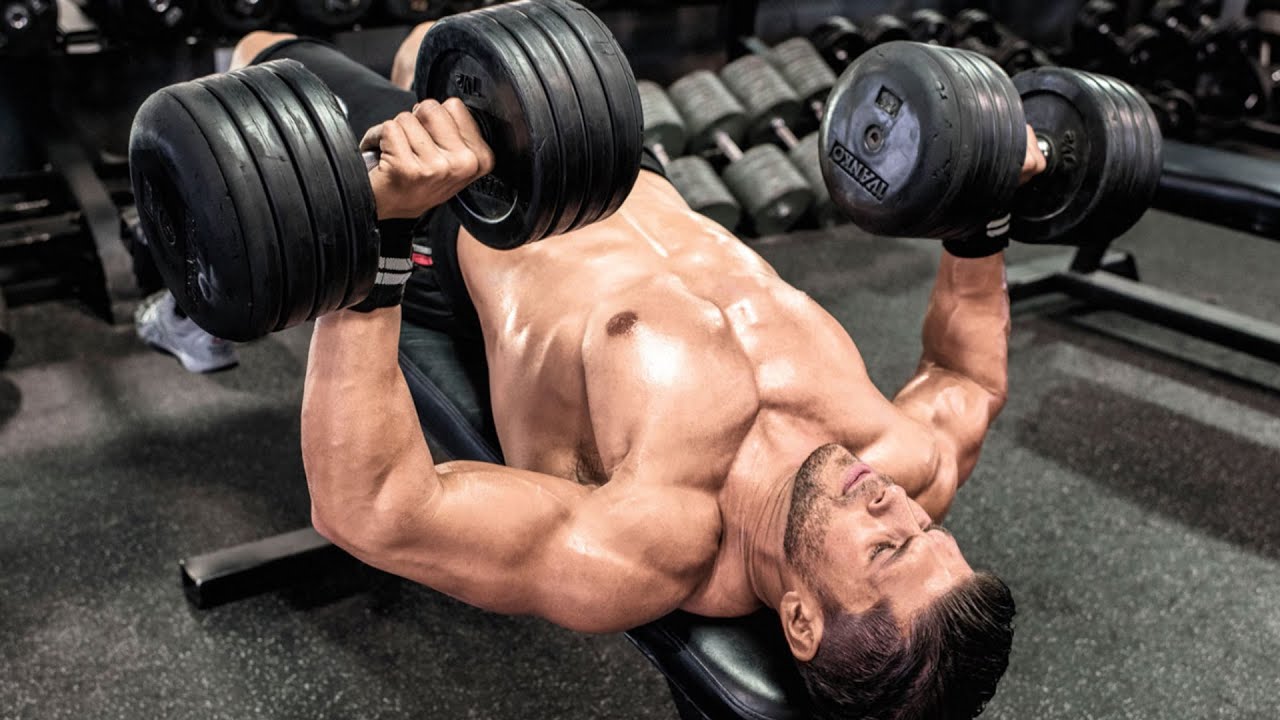The lower chest is one of the hardest areas to train because most chest workouts focus on the upper pecs.
Well, it’s time to give some love to those lower chest muscles. Trust me, a well-rounded chest doesn’t just look great – it can seriously up your strength, too.
That is why it is so important to include these best lower chest exercises in your routine.
Let’s discuss the best lower chest exercises (based on science and experience). Plus, I’ll share some insider tips on form and technique that I’ve picked up over the years.

- How to Train the Lower Chest
- 1. Pressing Position
- 2. Body Position
- 3. Training Volume
- 10 Best Exercises To Build The Lower Chest
- 1. Decline Barbell Press
- 2. Decline Dumbbell Press
- 3. Decline Dumbbell Fly
- 4. Parallel Bar Dip (Chest Dip)
- 5. High Cable Fly
- 6. Decline Cable Fly
- 7. Incline Push-Ups
- 8. Dumbbell Pullover
- 9. Seated Machine Fly
- 10. Smith Machine Decline Bench Press
- Complete Workout Plans To Train Lower Chest
- Beginner Lower Chest Workout Plan
- Intermediate Lower Chest Workout
- Advanced Chest Workout
- Advanced Techniques To Train The Lower Chest
- 1. Supersets
- 2. Drop Sets
- 3. Pause Reps
- 4. Eccentric Training
- 5. Rest-Pause Training
- FAQ
- Are lower chest exercises necessary?
- Do you have to train the lower chest?
- How often should you work your lower chest?
- Conclusion
- References:
- 10 Best Lower Chest Exercises To Build Your Pecs
How to Train the Lower Chest
Training your lower chest isn’t as straightforward as targeting other muscles, like your biceps. You won’t find one exercise that directly isolates that exact area of the chest muscle group as curls do for your arms.
Chest exercises will engage the complete muscle group more broadly, so you’ll also be training the other area of your pectorals as you aim to hit the lower portion.
You can change up the angles on some of these exercises to give your muscles a different stimulus to better activate the lower chest—some studies do suggest this method might be effective.
Here are some key tips for practical lower chest training.
1. Pressing Position
The pectoral muscles work differently depending on the angle you bring your arm forward.
- The incline bench press primarily targets the clavicular head of the pectoralis major (upper chest muscle fibers).
- The decline bench press targets more of the sternal head (lower chest muscle fibers).
- In contrast, the flat bench press is a more evenly distributed chest exercise that activates the sternal (lower) and clavicular (upper) heads.
Research indicates that the correct angle for the decline bench press should be 15–30 degrees declined from flat in order to target the lower chest.
Even though 15-30 degrees may seem like a slight angle, it is the proper decline for placing the strain on your lower pecs and minimizing the effect on the anterior deltoid muscles.
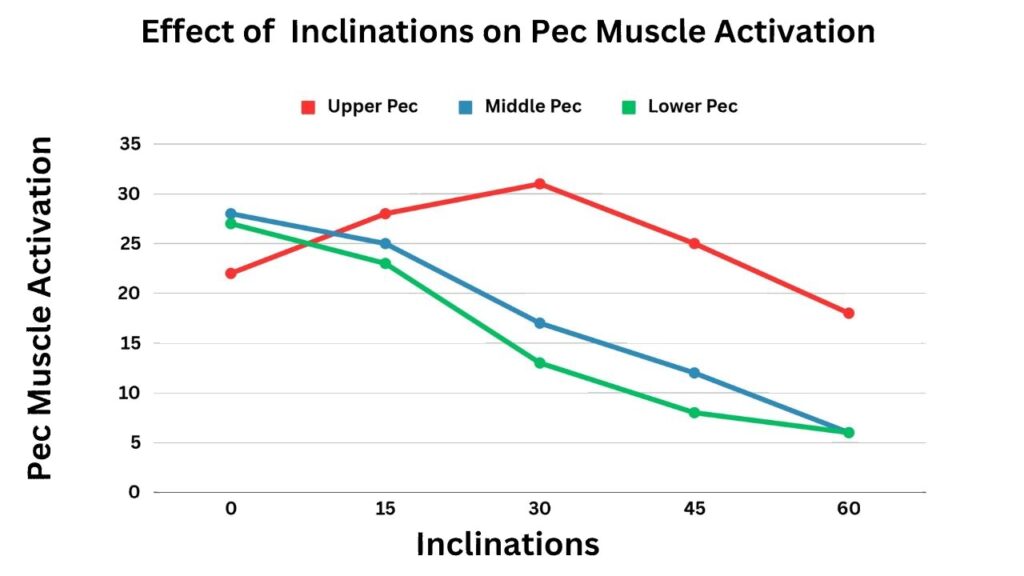
2. Body Position
In Inline push-ups, the surface is slanted, so more of your lower chest, shoulder, and tricep muscles are used.
Incline push-ups are easier than normal push-ups because of the angle at which they have to be done.
3. Training Volume
Strength, Hypertrophy and Endurance table of Mell Siff’s Supertraining
- Strength Gains: Do 3–5 reps with at least 85% of your one-repetition maximum (1RM). For fewer reps, aim for closer to 90% of your 1RM.
- Hypertrophy (Muscle Growth): Do 8 to 12 reps per set with 60 to 80% of your 1RM.
- Endurance: It enhances cardiovascular and muscular endurance. Use a load within 40 to 60% of your 1RM range and do 15 to 20+ reps per set.
10 Best Exercises To Build The Lower Chest
Here is a list of the 10 best lower chest exercises for building a well-developed chest. You can also find out how to put together a lower chest workout.
1. Decline Barbell Press
If you’re looking for straightforward chest exercises to add to your lower chest workout routine, then the decline bench press is a great staple exercise to get you started.
Although the flat version works on the complete chest, the decline press specifically focuses on the lower chest.
It is performed on a decline bench with the head positioned lower than the hips. This angle places greater emphasis on the lower chest and aids in its growth in size, strength, and definition.
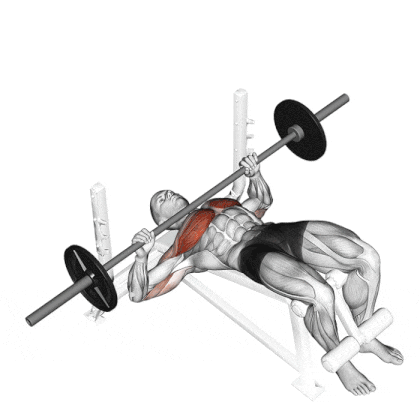
How To Do
- Adjust the decline bench to a suitable angle (usually around 15 to 30 degrees).
- Secure your feet at the end of the bench to maintain stability.
- Position yourself on the decline bench with your head lower than your hips.
- Grasp the barbell with a grip slightly wider than shoulder-width.
- Lift the barbell off the rack and hold it directly above your chest with extended arms.
- Slowly lower the barbell towards your lower chest while maintaining control and a steady pace. Aim to bring the barbell to the mid/lower chest area.
- Push the barbell back up to the starting position.
Tips for Proper Form
- If you’re lifting heavy weights, it’s recommended to have a spotter
- Keep a controlled motion and avoid jerky movements.
- Keep the bar in line with your wrists and elbows, and make sure it moves straight. To keep the wrist straight, try to position the bar as low as possible in the palm while still being able to wrap the thumb.
- Keep your shoulder blades retracted, and don’t let them change position while you perform the movement.
- The glutes and shoulder blades should remain in contact with the bench throughout the movement.
2. Decline Dumbbell Press
The decline dumbbell bench press is an upper body workout that engages the lower pec muscles, the triceps, and the anterior deltoid muscles of the shoulders.
Doing a decline press with a dumbbell gives you a greater range of motion during the exercise. Dumbbells also require a high level of shoulder stability, which requires more muscle fibers to stabilize the body than barbells.
This flexibility can enhance range of motion, joint wellness, and muscle activity throughout the lower chest.
Try different hand and grip positions to target your muscles from various angles to add variety.
- Neutral Grip Decline Dumbbell Press
- Single-Arm Decline Dumbbell Press
- Decline Dumbbell Squeeze Press

How To Do
- First, adjust the decline bench press angle to 15-30 degrees. And then lie on your back with your face upward.
- With your form right, grab the dumbbell. The grip should be slightly wider than the width of your shoulders.
- Hold the weights above you at shoulder height.
- Now, extend the weights to the top overhead, feeling a good chest muscle contraction.
- Lower the dumbbells to the starting position and feel a good stretch in your lower pecs.
Tips for Proper Form
- Keep your back pressed firmly against the bench and avoid excessive arching.
- Don’t use momentum or bounce the weights off your chest. Maintain greater tension in the pecs by not completely locking the elbows.
- Don’t let the dumbbells hit each other at the top of each rep: Hitting them could cause you to lose stability in your shoulders and injure yourself.
3. Decline Dumbbell Fly
The decline dumbbell fly is a fly variation performed on a slight decline, which targets the lower chest muscles slightly more than the flat and incline fly variations.
While multi-joint exercises engage more muscles and allow for heavier weights, single-joint isolation exercises like the decline dumbbell fly enable you to target specific muscles more precisely. This approach makes it easier to focus on and develop the lower chest.
This isolates the lower chest muscles even more because the triceps and shoulders are less involved.
There are several variations of the decline dumbbell fly that you can try to add variety and challenge to your lower workout routine.
- Single-arm decline dumbbell chest fly,
- The decline chest fly with a twist
- Decline dumbbell chest fly with a neutral grip
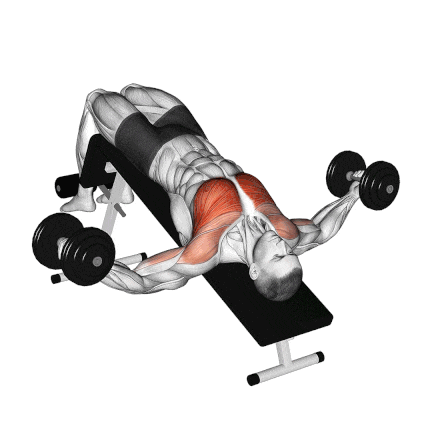
How To Do
- Grab a dumbbell in each hand and lie on your back on a decline bench. Hook your feet into the footpad or roller.
- Extend the dumbbells above your chest. Turn the palms to face each other and the dumbbells directly over your upper chest.
- Slowly lower the dumbbells down in a wide arc, keeping your elbows slightly bent until your arms are parallel to the floor.
- Pause briefly, then bring the dumbbells back up to the starting position.
- Do 8–12 reps and 3–4 sets.
Tips for Proper Form
- Don’t let the dumbbells touch as they meet at the top, holding for a second in the contracted position.
- Keep your elbows bent. You should never fully straighten your arms or lock them out, as this forces the weight you’re lifting onto the elbows and shoulder joints.
- Use a slight decline, such as 30 degrees. Extremes are never the best option.
4. Parallel Bar Dip (Chest Dip)
The parallel bar dip is a compound bodyweight exercise that primarily targets the chest muscles (pectoralis major), triceps, and shoulders.
Parallel bar dips allow for a greater range of motion than many chest exercises. When performing dips, you should lean forward rather than upright to train the lower chest effectively.
The dip’s range of motion allows for a deeper stretch on the lower chest and triceps, resulting in greater strength and muscle growth.
To make the chest dip harder, you can add belts, chains, and weighted vests. However, it is recommended that you first master the standard version of the exercise before adding equipment.
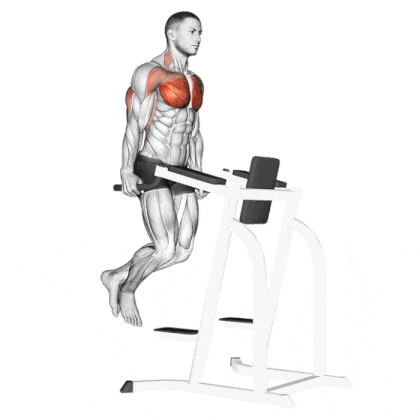
How To Do
- Stand between two parallel bars, grasping each bar.
- Lift your body off the ground by pushing down on the bars and supporting your weight on your hands.
- Keep your torso upright, engage your core, and slightly lean forward to shift the emphasis onto your lower chest muscles.
- Lower your body by bending your elbows until your shoulders are slightly below your elbows. Maintain control and smooth movement.
- Push back up by straightening your arms, focusing on squeezing your chest muscles and triceps.
Tips for Proper Form
- Be careful of the tension on your shoulders. Do not descend any lower if you start to feel much tension.
- To do more specific work on the pectorals , try to lean as far forward as possible. Do not do a full movement, because the higher you raise yourself, the more the triceps work
- Hold a dumbbell between your legs if you need additional resistance.
5. High Cable Fly
The high-to-low cable fly, a variation of the chest fly, is a great exercise for targeting the lower portion of your chest. It primarily targets the lower chest but also, to a lesser degree, the shoulders and triceps.
Unlike compound exercises such as bench presses, which target the chest, triceps and shoulders, the high cable fly takes the shoulders and triceps mainly out of the picture and solely targets the chest. This makes it an ideal exercise for building large, symmetrical pecs.
Cable provides constant resistance and helps develop the lower and the central chest muscles by providing much-needed stress in the lower and inner chest.
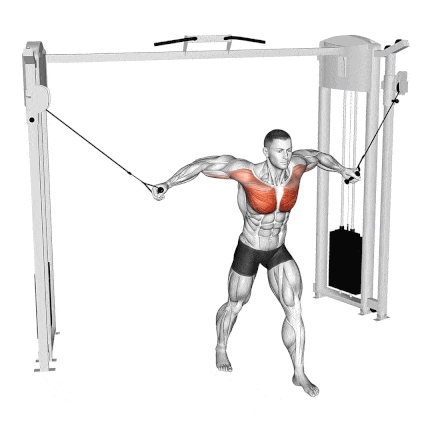
How To Do
- Set both pulleys as high as possible and select the desired weight.
- In a standing position, grab the handles with a neutral grip.
- Bend slightly forward and extend your arms, feeling a good stretch in your chest muscles.
- Bend your elbows slightly and pull your hands (high to low) toward each other in wide arcs in front of you, pausing when your hands touch.
- Slowly lower back to the starting position and repeat for the desired number of repetitions.
Tips for Proper Form
- Ensure you maintain some tension in your abs and don’t allow your lower back to arch excessively.
- Keep your torso stable and core engaged. When you bring the handles forward, avoid excessive arching of the lower back.
- Move the handles in an arc-like motion in front of your body, rather than straight out to your sides. This arc targets the pecs better.
- Keep your feet shoulder-width apart or in a staggered stance for better balance.
6. Decline Cable Fly
Decline Cable fly is one of the most suitable exercises for isolating the lower chest muscles. During the exercise, you will use a cable machine with handles attached at the bottom while lying on a decline bench.
The handles are pulled inward and upward in a sweeping motion, crossing in front of the chest, to work the lower chest muscles.
It is usually performed after big compound lifts, like the bench press and dumbbell press.

How To Do
- Set a Decline bench at a 30-degree angle. Lie on the bench with your feet flat on the foot pad or the roller.
- Lift your arms straight up from your shoulders and hold the cable handle directly over your chest.
- Slowly lower your arms out to your sides until your wrists come to about shoulder level or slightly above.
- Bring your arms back toward the midline of your body, focusing on using your lower pec muscles to draw them back together.
Tips for Proper Form
- Vary the position of the bench to hit different angles of the lower chest.
- Hold and contract the chest muscles when hands are together.
- Set the bench at about 30 degrees decline.
7. Incline Push-Ups
Incline push-ups are one of the best lower chest bodyweight exercises that you can do at home. Pushups are a great multi-functional exercise because they work the entire upper body and back.
The Incline Push-up is one of the greatest conditioning exercises for the outdoor athlete, it can be performed, regardless of where you are and, best of all, they are completely free—no expensive equipment or no annual gym fees required. You only need a stable surface such as a table, desk, or wall.
As with many push-up variations, you can potentially rep out for added volume.
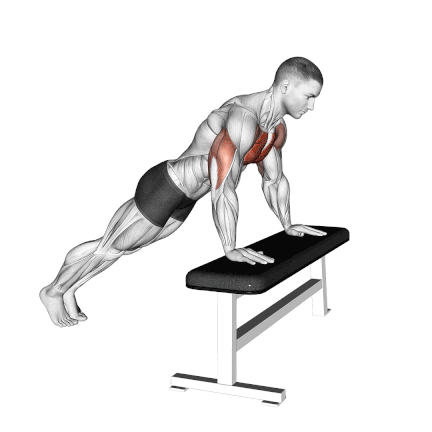
How To Do
- Stand in front of the bench. Place the hands shoulder-width apart on the edge of the bench.
- Adopt an incline plank position by extending the legs backward until the legs and back form a straight line.
- Slowly bend the arms to lower the chest toward the bench.
- Remember to keep the elbows and arms close to the body.
- Slowly push the body away from the bench, extending the arms but maintaining a slight bend in the elbow.
Tips for Proper Form
- Be sure the bench or chair is stable and secure before you perform the push-ups.
- Stand at a comfortable distance from the bench.
- Do not let your lower back sag or your butt rise. Ensure your body is straight and rigid.
- Slow down all of your movements and really stay focused on your form.
Know More: Best Push-Ups For Lower Chest That You Can Do At Home
8. Dumbbell Pullover
Dumbbell Pullovers are the best exercise for building a strong rib cage and serratus anterior muscle, which together form a complete chest and back.
This dual muscle engagement can help build upper body strength and muscle definition. It also engages the core muscles, which stabilize your body on the bench.
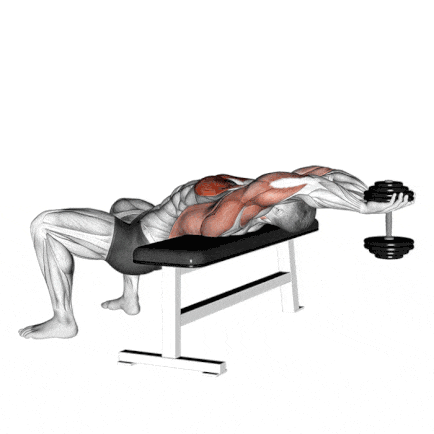
How To Do
- Lie across on a bench on your shoulders so that your head is hanging.
- Grasp a dumbbell with both hands and get it straight over your chest.
- Extend your arms overhead and slightly behind your head, slightly bending your elbows.
- Lower the dumbbell in an arc, slowly getting a good stretch in your rib cage.
- Lower the dumbbell as far as possible and then raise it back to the starting position.
Tips for Proper Form
- Keep your core engaged, and press your back against the bench.
- Maximum stretching ensures the greatest expansion of the rib cage.
- Relax your hips and let them fall, as relaxed hips help in extra expansion.
- Inhale as you lower the dumbbell, and exhale as you lift it back to its starting position.
9. Seated Machine Fly
The seated machine fly is a popular exercise that targets the chest muscles. It allows for focused isolation of the lower chest, helping to develop and strengthen it.
It allows you to focus on the mind-muscle connection and feel the chest muscles contracting while you exercise.
There are many different ways to fly a machine that require different types of equipment.
- Single-Arm Seated Machine Fly
- Elbow-Supported Pec Deck Fly
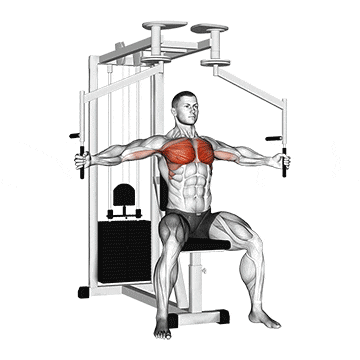
How To Do
- Sit on the machine, taking care to place your back flat against the pad.
- Grab the vertical handles with elbows slightly bent.
- Keep your chest lifted, shoulders relaxed, and feet planted firmly on the ground.
- Start with your arms extended out to the side, with your elbows slightly bent.
- Contract your chest muscles and bring the handles or grips together in front of your chest.
- Squeeze the handles together until they touch in front of your chest.
- Slowly and under control, reverse the motion and let your arms move back out to the sides.
Tips for Proper Form
- Your upper arms should be parallel to the floor.
- Keep your eyes straight ahead while performing the exercise.
- Try to bring the handles together so that your hands meet your chest.
10. Smith Machine Decline Bench Press
Finally, if you’re looking for one more effective lower chest exercise, try the smith machine decline bench press.
The Smith Machine bench press is a variation of the traditional bench press exercise that requires a Smith machine. This setup provides an added level of stability compared to traditional free-weight bench presses.
It eliminates some of the need for shoulder stability during the exercise, allowing the lifter to isolate the lower chest muscles better.
Research indicates that the correct angle for the decline bench press should be 15–30 degrees declined from flat to target the lower chest.
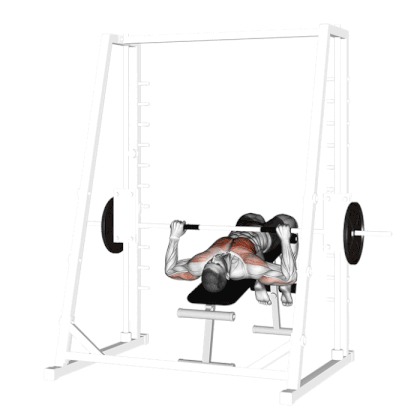
How To Do
- Set up the Smith machine by putting a decline bench in the middle of the guided frame.
- Move the bar to hip height and add the load you want to train with.
- Lie flat on a decline bench inside the Smith machine and set your hands just outside of shoulder width.
- Unhook the bar and slowly lower it in a straight line to the base of the sternum (breastbone), touching the chest.
- Pause, then slowly raise the bar as far as possible without locking your elbows.
- Continue until you have completed all the planned repetitions.
Tips
- Use a shoulder-width grip or slightly wider. Do not grip the bar too narrowly.
- Unrack the bar with control, keeping your elbows tucked in close to your sides. Avoid flaring your elbows out.
- Keep your head, shoulders, and buttocks in contact with the bench.
- Elbow position is essential for an effective and pain-free bench press. You risk elbow pain if you tuck your elbows too far toward your torso. On the other hand, if you spread your elbows too far, you risk shoulder injuries.
Complete Workout Plans To Train Lower Chest
If you want to balance your chest workout, add 1-2 of the following lower chest exercises. We recommend that you train your entire chest during your chest workouts because your lower chest muscles are a small part of your whole chest.
- If your lower chest is considerably undeveloped, I suggest choosing 2 of these exercises, and performing 1 at the start of your Chest workout.
- If your lower chest is well-developed but you’re looking to continue to add mass, I suggest choosing only 1 exercise.
Before you start a chest workout, make sure you warm up properly. Then, do a few warm-up sets with lighter weights or just your body weight before doing the exercises with heavier weights.
Beginner Lower Chest Workout Plan
If you’re new to lifting weights, don’t worry. This beginner-friendly chest workout routine is a great place to start.
When this gets easy, choose a heavier free weight. After you’ve upped your weight several times and feel strong in the movements below, move on to the intermediate routine.
| Exercise | Sets | Reps | Rest |
|---|---|---|---|
| Incline Push-Ups | 4 | 8-12 | 60-90 sec |
| Decline Dumbbell Press | 4 | 8-10 | 60-90 sec |
| Cable Fly | 3 | 8-10 | 60-90 sec |
Intermediate Lower Chest Workout
| Exercise | Sets | Reps | Rest |
|---|---|---|---|
| Dumbbell Bench Press | 4 | 8-10 | 60-90 sec |
| Decline Barbell Press | 4 | 8-12 | 60-90 sec |
| High Pulley Crossover | 3 | 8-10 | 60 sec |
| Dumbbell fly | 3 | 12-15 | 60 sec |
Advanced Chest Workout
| Exercise | Sets | Reps | Rest |
|---|---|---|---|
| Decline Barbell Bench Press | 4 | 8-10 | 60-90 sec |
| Machine Fly | 4 | 8-12 | 60 sec |
| Decline Cable Fly | 3-4 | 8-10 | 45-60 sec |
| Smith Machine Press | 3 | 12-15 | 45-60 sec |
| Incline Push-Ups | 3 | 15-20 | 60 sec |
Advanced Techniques To Train The Lower Chest
When it comes to training in the lower chest, advanced techniques can help to grow more muscle and improve overall development.
Here are some advanced ways to work on your lower chest:
1. Supersets
Combine two exercises that work on the lower part of your chest in a superset way.
For instance, perform a set of decline dumbbell presses immediately followed by a set of decline fly, without any rest in between.
Supersets increase training intensity, promote muscle fatigue, and enhance the overall effectiveness of your workout.
2. Drop Sets
Start with a heavier weight and perform an exercise until failure. Then, immediately reduce the weight and continue the set without rest.
Drop sets help increase muscle fatigue and recruit additional muscle fibers for greater stimulation.
3. Pause Reps
During your sets, incorporate pauses at different points of the exercise to increase the time under tension and further challenge the muscles.
For example, perform a Decline bench press and pause for 2-3 seconds at the movement’s bottom, mid-range, or top. This technique stimulates greater muscle recruitment and promotes muscle growth.
4. Eccentric Training
Research has shown that eccentric training increases muscle growth and strength more than traditional training methods.
Eccentric training emphasizes the lowering (eccentric) phase of the exercise, which has been found to stimulate muscle hypertrophy.
To incorporate this technique, perform the eccentric phase of the exercise (e.g., lowering the weight during a decline bench press) slowly and under control.
5. Rest-Pause Training
According to research, rest-pause training results in a greater level of muscle activation and metabolic stress than traditional sets.
Rest-pause training involves performing a set to failure, briefly resting (10-20 seconds), and then continuing with additional reps using the same weight.
This technique helps to recruit more muscle fibers and increase training volume.
FAQ
Are lower chest exercises necessary?
Lower chest workouts in your first few days of weight lifting are unnecessary. However, once you start to feel your chest muscles growing, you will need to start doing lower chest exercises in your chest training routine to achieve well-defined chest muscles.
Do you have to train the lower chest?
Yes, to build a well-defined, stand-out chest, you have to target the lower chest. The best way to add size and strength to your chest is to press, press, do a fly, and press some more.
How often should you work your lower chest?
You should train your lower chest 1 to 2 times per week to build mass and strength. If your goal is muscle hypertrophy, then you should do 8-12 repetitions per set.
If you want to tone your muscles, then 1–3 sets of 12–16 repetitions should be sufficient.
Conclusion
This best lower chest exercise and workout plan is highly recommended for anyone interested in building upper body strength and gaining muscle. To achieve a well-balanced physique, add these exercises to a full-body strength training routine.
It allows for targeted muscle development and provides an overall body workout. Furthermore, it is easy to do and requires no more scientific details. If done consistently, the results will speak for themselves.
Thanks for reading, enjoy working your chest training.
Stay Fit, Live a Happy and Healthy Life
References:
- Saeterbakken, Atle Hole et al. “The Effects of Bench Press Variations in Competitive Athletes on Muscle Activity and Performance.” Journal of human kinetics vol. 57 61-71. 22 Jun. 2017, doi:10.1515/hukin-2017-0047Snyder, Benjamin J, and Wesley R Fry. “Effect of verbal instruction on muscle activity during the bench press exercise.” Journal of strength and conditioning research vol. 26,9 (2012): 2394-400. doi:10.1519/JSC.0b013e31823f8d11
- Solstad, Tom Erik et al. “A Comparison of Muscle Activation between Barbell Bench Press and Dumbbell Flyes in Resistance-Trained Males.” Journal of sports science & medicine vol. 19,4 645-651. 19 Nov. 2020
- Baz-Valle, E., Schoenfeld, B. J., Torres-Unda, J., Santos-Concejero, J., & Balsalobre-Fernández, C. (2019). The effects of exercise variation in muscle thickness, maximal strength and motivation in resistance trained men. PLOS ONE, 14(12), e0226989. https://doi.org/10.1371/journal.pone.0226989
- Figueiredo, Vandré Casagrande et al. “Volume for Muscle Hypertrophy and Health Outcomes: The Most Effective Variable in Resistance Training.” Sports medicine (Auckland, N.Z.) vol. 48,3 (2018): 499-505. doi:10.1007/s40279-017-0793-0
10 Best Lower Chest Exercises To Build Your Pecs

Manish is a NASM-certified fitness and nutrition coach with over 10 years of experience in weight lifting and fat loss fitness coaching. He specializes in gym-based training and has a lot of knowledge about exercise, lifting technique, biomechanics, and more.
Through “Fit Life Regime,” he generously shares the insights he’s gained over a decade in the field. His goal is to equip others with the knowledge to start their own fitness journey.

